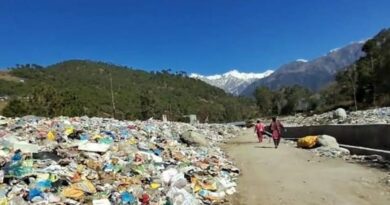Himachals Railway dream or Ecological Nightmare?
The Truth behind the Bhanupali-Bilaspur-Beri (BBB) Railway Project
The promise of railway connectivity through Himachal’s mountains sounds like a dream come true. The Bhanupali-Bilaspur-Beri (BBB) Railway Project — a 63-kilometre broad-gauge line linking Himachal with India’s national rail network — has been pitched as a lifeline for the state’s remote regions. But behind this promise, environmental experts see a troubling reality: another chapter in the long story of development at the cost of ecology.
A recent study by Garima Thakur, published in the LEAD Journal (August 2025), argues that the BBB project symbolizes the replication of plains-style industrial development in a fragile Himalayan ecosystem — a formula that has already unleashed landslides, flash floods, and devastation across Himachal Pradesh.
The Development Paradox
For years, Himachal Pradesh has stood at the crossroads of two competing ambitions — economic growth versus environmental survival. Once an agrarian, self-sustaining hill state, Himachal’s landscape has been reshaped by mega projects: four-lane highways, tunnels, hydropower dams, and cement factories.
These projects, the paper notes, have been greenlit under India’s environmental laws — yet the same laws have failed to prevent the annual monsoon disasters that now define the region. Every year, cloudbursts, flash floods, and landslides rip through newly built infrastructure, only to be rebuilt again in the same way.
Thakur calls the BBB railway line “another assault on the mountains,” arguing that it perpetuates a cycle of extractive growth rather than sustainable progress.
The Project and Its Promise
The BBB line, first proposed in the mid-1990s and sanctioned in 2008, only gained traction after Rail Vikas Nigam Limited (RVNL) took over in 2015. While the project aims to boost connectivity and tourism, it also lays the groundwork for extending the railway network toward Leh — passing through ecologically sensitive areas like Kullu, Manali, and Lahaul-Spiti.
Supporters see this as progress. But critics fear it’s an open invitation to ecological disaster, especially in a state already struggling with fragile slopes, deforestation, and extreme weather events.
Legal Loopholes and the Myth of “Green” Approval
The study exposes how the BBB railway was approved despite major environmental concerns. Under Indian law, large infrastructure projects must secure environmental, forest, and wildlife clearances. Yet the BBB project managed to obtain all approvals without a full environmental impact assessment.
Two Social Impact Assessments (SIAs) — by PLAN Foundation (2022) and SR Asia (2021) — admitted that over 51,000 trees would be felled but claimed that soil erosion and deforestation would be “insignificant.” Thakur calls this a gross understatement, noting that Himachal’s landslides and floods often stem from reckless soil excavation and muck dumping.
Perhaps most alarming, the Himachal Forest Department relied on a misinterpreted Supreme Court order meant for small rural projects like schools and health centres — not for commercial-scale rail construction — to justify clearing forestland.
Meanwhile, the Railways Act of 1989 provides a powerful loophole: Section 11 allows railway projects to bypass environmental clearances entirely. Backed by a 2022 Bombay High Court ruling and a 2023 government notification, the BBB line effectively escaped environmental scrutiny.
The “Cost-Benefit” Illusion
In what Thakur calls a deeply flawed approach, the project’s cost-benefit analysis converted the value of forests, wildlife, and ecosystem services into rupee figures — declaring that the economic gains vastly outweighed the environmental losses.
But such accounting, she argues, reduces living ecosystems to mere numbers, ignoring their intrinsic worth. “When we price a forest in lakhs,” she writes, “we forget that its loss cannot be reversed with money.”
National Security or Environmental Bypass?
The BBB project’s expansion plans are tied to a familiar justification — national security. Officials describe it as a project of “strategic importance,” potentially extending to Leh for military logistics.
However, this reasoning mirrors the one used to push the Char Dham highway project in Uttarakhand, which led to massive deforestation and slope destabilization. Under the 2023 amendments to the Forest Conservation Act, “strategic linear projects” within 100 km of India’s borders are exempted from forest clearance — effectively giving a green light to massive construction across the Himalayas.
Thakur warns that national security is fast becoming an excuse for environmental deregulation, opening the door to unrestrained exploitation of mountain ecosystems.
Local Voices and the Mirage of Prosperity
Unlike earlier protests against hydropower and cement plants, local opposition to highways and railways has been muted. Many communities view these projects as signs of progress — a promise of jobs, tourism, and compensation.
This acceptance, the study says, stems from a neoliberal mindset that equates development with consumption and urban expansion. “In the hills,” Thakur observes, “people have begun to aspire to the same development model that has destroyed the plains.”
Yet the reality is harsher. A public interest litigation in Bilaspur has already flagged structural damage to poor families’ homes caused by tunnel construction. With every monsoon, these “symbols of progress” collapse under the weight of their own design flaws.
A Systemic Failure of Environmental Law
India’s environmental laws, Thakur argues, have become reactive and anthropocentric — focused more on procedural compliance than genuine protection. Instead of preventing harm, they enable it through complex clearances and monetized compensation.
However, the tide may be turning. In July 2025, the Supreme Court of India issued a landmark order acknowledging the ecological crisis in Himachal. The Court condemned the state’s revenue-driven policies and called for a new Himalayan development framework — one that respects the region’s geology, ecology, and culture. It also launched a suo motu PIL to monitor destructive infrastructure projects, signalling a potential judicial course correction.
Toward a New Vision for Himachal
Thakur concludes that while railways can be a greener alternative to highways, their construction in Himachal’s terrain demands context-specific planning. Without considering the state’s fragile ecology, even “green” projects can become catastrophic.
The BBB railway, she warns, is not just a train line — it’s a test case for whether India can balance infrastructure ambitions with environmental wisdom. Himachal’s development model, she insists, must be rooted in its ecology, culture, and traditional livelihoods, not borrowed from the plains.
Real progress, the paper suggests, lies not in more tunnels or trains, but in strengthening local schools, hospitals, and sustainable agriculture — investments that uplift people without undermining the land they live on.



